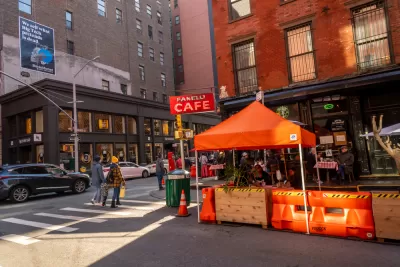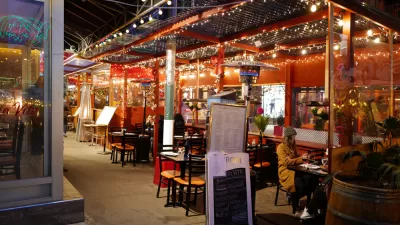While New York City's effort to make its outdoor dining program permanent is a welcome reimagining of public space, some worry that regulations will reduce design diversity and increase costs for small restauranteurs.

Diana Budds laments the potential loss of creativity and originality that characterized New York City's pandemic-era "streeteries," the often spontaneous, thrown-together outdoor dining setups used by restaurants to continue serving customers while observing social distancing and other COVID-19 safety measures. The variety of interesting structures created by restaurant owners, writes Budds, is "coming to an end, as DOT develops permitting rules for open restaurants. Enjoy the weird, comical, and eccentric structures while you can."
Budds doesn't disapprove of the city's push to make outdoor dining a permanent enhancement of public space. But, unfortunately, "design standards and sameness are a tag team," says Budds, and the regulations will likely stymie the creative efforts seen in the past two years.
So far, we’ve seen kinetic structures, pastel-pink arched arcades, yurts, and faux railcar diners, bungalows that look indistinguishable from the interiors of the four-star restaurant they belong to, cottagecore embellishments, greenhouses, and architectural ducks. I relished the little details that restaurants incorporated into their designs, like a pizza restaurant on Smith Street using spent cans of tomato sauce for planters, and a natural-wine bar on Centre Street that added a towering flower-shaped cistern to its streetery to collect rainwater.
But once clear rules are in place, that experimentation will likely recede into more uniform—but potentially safer and more accessible—structures. Meanwhile, "Landlords are already looking for ways to inflate rents for spaces with sidewalk space and parking space adjacency." Budds also warns that more regulations will make it more difficult for small businesses to participate, potentially turning the vibrant open-air restaurant boom into another "mediocre, passable, and inoffensive" industry dominated by chains.
An article in the New York Daily News by Sara Lind and Jackson Chabot similarly supports keeping outdoor dining around, saying "countless New Yorkers have grown to love it, as demonstrated by the always bustling streeteries and very supportive survey results." The authors advocate for "design guidelines that ensure on-street dining is part of a cohesive streetscape that is vibrant and well-ordered. Rather than permanent structures, we envision movable tables and chairs with umbrellas or other overhangs." The article also draws attention to the conflict between curb use by restaurants and bike lanes, noting the need to protect both bike riders and restaurant customers from traffic and collisions, and makes other suggestions for regulating outdoor dining space for maximum effectiveness and safety.
Ultimately, Lind and Chabot write, "It has never been more clear that free, on-street parking is not the best or highest use of that valuable space, nor the fairest or most economically sound." Neither should restaurants and businesses get to use public space for free. Noting the need for a comprehensive policy that improves streetscape in other ways, the authors "call on the city to create a framework and structure for better coordination, stewardship and management of public space, including the Open Restaurants program."
FULL STORY: The Era of Experimental Streeteries May Soon Be Over

Study: Maui’s Plan to Convert Vacation Rentals to Long-Term Housing Could Cause Nearly $1 Billion Economic Loss
The plan would reduce visitor accommodation by 25,% resulting in 1,900 jobs lost.

North Texas Transit Leaders Tout Benefits of TOD for Growing Region
At a summit focused on transit-oriented development, policymakers discussed how North Texas’ expanded light rail system can serve as a tool for economic growth.

Using Old Oil and Gas Wells for Green Energy Storage
Penn State researchers have found that repurposing abandoned oil and gas wells for geothermal-assisted compressed-air energy storage can boost efficiency, reduce environmental risks, and support clean energy and job transitions.

Santa Barbara Could Build Housing on County Land
County supervisors moved forward a proposal to build workforce housing on two county-owned parcels.

San Mateo Formally Opposes Freeway Project
The city council will send a letter to Caltrans urging the agency to reconsider a plan to expand the 101 through the city of San Mateo.

A Bronx Community Fights to Have its Voice Heard
After organizing and giving input for decades, the community around the Kingsbridge Armory might actually see it redeveloped — and they want to continue to have a say in how it goes.
Urban Design for Planners 1: Software Tools
This six-course series explores essential urban design concepts using open source software and equips planners with the tools they need to participate fully in the urban design process.
Planning for Universal Design
Learn the tools for implementing Universal Design in planning regulations.
Ascent Environmental
Borough of Carlisle
Institute for Housing and Urban Development Studies (IHS)
City of Grandview
Harvard GSD Executive Education
Toledo-Lucas County Plan Commissions
Salt Lake City
NYU Wagner Graduate School of Public Service





























